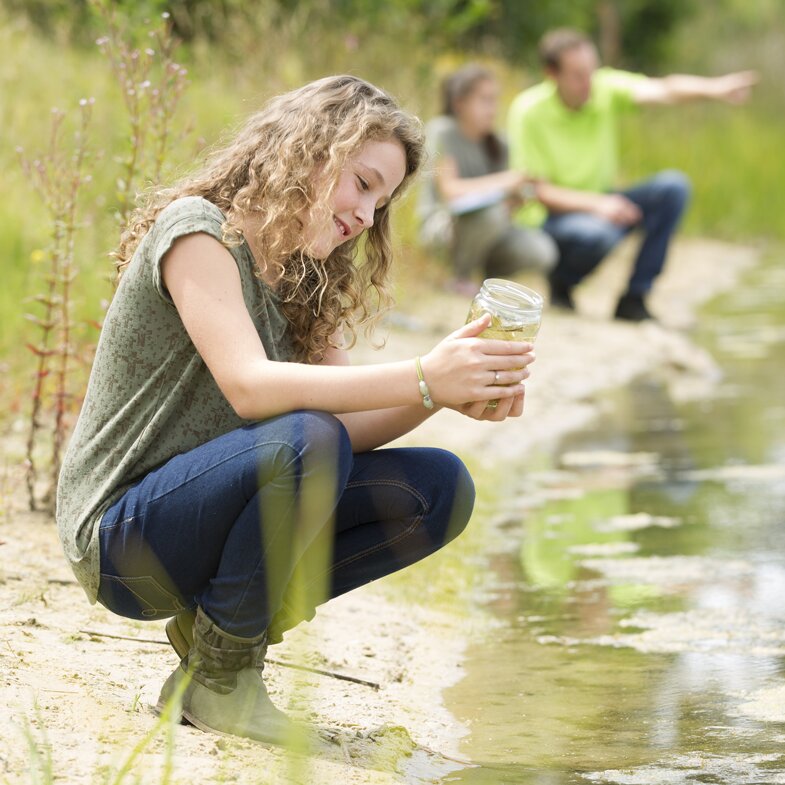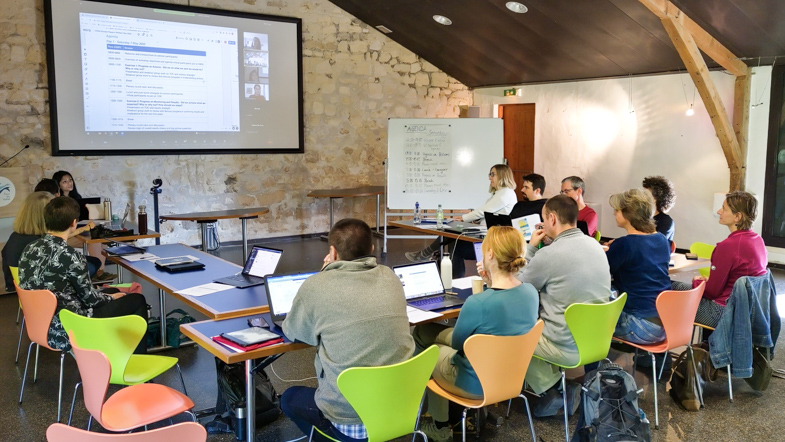
Are you making an impact? – How to pause, reflect, and adapt to achieve your goals
Pausing to reflect and adapt is a cornerstone of adaptive management. As a tool for conservation, it is enormously valuable and can be applied in a simple way. FOS has helped countless teams all over the world with their pause-and-reflect processes, for example when CCNet Europe reviewed its strategic plan.
Contents |
It’s a Sunday evening in May and dusk is settling on the wetlands in Camargue, France. A group of 14 conservation coaches, happy but drained, are sauntering out of an old sheep shed converted into a research library and meeting space. They have just concluded the first pause-and-reflect workshop of Conservation Coaches Network (CCNet) Europe.
Before heading home after a long weekend, Lisa Ernoul is locking up the doors. She is coordinator of management and restoration at Tour du Valat, a research centre for conservation of Mediterranean wetlands, which has hosted the weekend. She is also a board member of CCNet Europe.
“This was an incredible learning experience,” Lisa says. “It really clarified our strategy for me and opened my eyes. Now I really know what our objectives are and how to respond to requests.”
The need to pause, reflect, and adapt: CCNet's story
CCNet Europe is a network of individual conservation coaches, founded in 2010. Together, they share the aim of strengthening conservation in Europe through adaptive management.
Four years ago, the network updated its strategic plan, developed a theory of change, and set up a plan for monitoring and evaluating its work and results. While the team implemented the plans, it came across some important questions about the network’s structure, strategies, and sustainability.
As a result, the network decided to review its plans. In May 2022, CCNet Europe arranged a structured pause-and-reflect (P&R) workshop based on the collected data and facilitated by FOS. For FOS Europe, supporting CCNet throughout its journey is an investment into our strategic mission work to help communities and organisations implement good conservation practice.
Benefits beyond the expected
A pause-and-reflect process is just what it says on the tin: pausing your day-to-day work and stepping back to reflect on what you’re doing, why you’re doing it, and how it’s going. The aim is to analyse your assumptions and results and to adapt your strategic plan as necessary.
Team-building
A participatory P&R also helps to clarify those whats, whys, and hows to the whole team, making it easier for them to work in a concerted way. By together talking through your vision, your theory of change, your objectives, etc. and getting everyone on the same page, you can ensure that the whole team pulls in the same direction.
In addition, involving the team boosts ownership and team spirit. When a group of people with different experiences and perspectives gets together in the same room and have a facilitated, rich discussion, it helps connect the team members and bind them together.
|
“Working together was very motivating. I think having this time to connect as a team made people want to stay committed to the network.” – Lisa Ernoul |
Data makes it objective
But if you do this without real-world data, the process can dissolve into focusing only on what you think you’re doing right or wrong, or into a debate between differing opinions. A good P&R is based on the right data, which makes the reflection more honest and objective.
Stella Vareltzidou is happy to see how CCNet Europe’s data collection really made a difference for the P&R. A consultant working with a variety of conservation projects as well as teaching conservation in universities in the Balkans and in Germany, she was involved in collecting the data and preparing for the P&R weekend.
“I have been in evaluations based on being happy that you are probably doing the right things,” Stella says. “The data can show that you’re not. There’s a lot of power in this. If something unexpected comes out of the data, that is interesting and makes the team more professional.”
So how to go about it?

CCNet Europe team in group work at their pause-and-reflect in May 2022. Photo by Felix Cybulla.
Three simple steps to pause and reflect
A P&R doesn’t have to be complicated or perfect. You can keep it simple by focusing on just a couple of key questions or parts of your strategy.
Step 1: Get the data
As mentioned above, objective data is crucial for making decisions that aren’t based only on intuition.
Data gathering and organising can require time and dedicated resources. But it’s possible to find low-cost approaches to get data that is good enough to help you forward. Depending on what data you need, you might pull it together from existing sources, or you might collect new data.
Once you’ve set up your data collection system, it often takes less time to keep it going, so you can get the continuous data that helps make informed decisions. Stella adds: “You might need to adapt your questions as you go. But don’t wait until you have the perfect data. It’s better to get the data you can with reasonable effort, do a P&R, and then refine for next time.”
Step 2: Reflect on progress and impact
Once the data is collected and organised into a useful form, you get the team together for the actual P&R process. CCNet Europe decided to spend the first day evaluating progress and impact through scorecards and progress markers visualised on large prints of the theory of change.
Here, progress means whether you’re on track with implementing your actions. Did you do what you said you would? If not, why not? What went well, what didn’t?
Impact, in contrast, means looking at the change you’re hoping to create with your actions. Are you seeing the results you expected after doing your work? If not, why not? What else is going on?
Step 3: Adapt based on progress and impact
When you have an idea of how things are going, the rubber really hits the road: Based on your assessment of progress and impact, what does that mean for how you use your time and treasure? What do you continue doing, what do you stop doing, what new actions can you add instead?
On the second day of CCNet Europe’s workshop, the team split into groups to work on a handful of “big-picture questions” about cross-cutting and fundamental topics. After recapping the group discussions, the team ended up with major adjustments in the theory of change, a decision to stop doing the multi-team workshops that had been a core part of the activities, and a wholly new structure in which to work.
|
“Sometimes these processes can be uncomfortable if you see that a strategy you’ve been committed to is failing. But we need to stop and see what we can do better, so that we can be successful in nature conservation. It makes our work more effective.” – Stella Vareltzidou |
What’s next?
After the P&R, you should have a galvanised team that is eager to start implementing the decisions made. It’s a good idea to use that momentum to get the ball rolling quickly.
For CCNet Europe, this means finalising the new theory of change and operationalising all the changes. For example, the new structure requires setting up a coordination team and a number of working groups focusing on different themes.
A shared language is key
In management planning, it’s important that everyone involved understands each other. If the team members have different ideas about what’s meant by terms like “objective” and “result”, or about what the vision is, it can be very difficult to manage the conversation and come to an agreement that everyone can commit to.
For CCNet Europe, the Conservation Standards (CS) provide such a common language. All CCNet coaches are already trained in the CS, and speaking in this shared language makes discussions easier. There may be differences of opinion, but at least there’s more clarity about what those opinions really mean.

This pause-and-reflect workshop was organised as a hybrid event with some CCNet Europe team members taking part remotely. Photo by Nico Boenish.
Top tips for pausing and reflecting
Based on their experience with CCNet Europe’s P&R, Lisa and Stella share some additional tips for how to make a P&R that’s successful and straightforward:
- Be clear on the aims, key questions, and background information, and make them available to participants ahead of time. This helps make sure people know what to expect and helps move the process along.
- Run P&Rs regularly so that the team stays connected to the discussions. CCNet Europe decided to revisit the process every 3–4 years, but other kinds of teams might choose to do it more often.
- Have an external facilitator in charge of running the sessions. An experienced facilitator who’s not part of the team can support the preparation by helping to choose the right aims, designing a workshop structure that engages the whole team, and keeping focus on the important questions. Especially if you don’t have very good data, a good facilitator can help get around the potential pitfalls.
|
“A huge benefit was having that experienced external facilitator, because it allowed each member to participate fully and not be responsible for facilitating the discussion.” – Lisa Ernoul |
The facilitator for this CCNet Europe workshop was Vinaya Swaminathan from FOS. “It was truly exciting and inspiring to see this team use their past experiences to define their path forward,” says Vinaya. “For me as a CS coach and facilitator, this proves how valuable and powerful the P&R process is when you have good data, a solid theory of change, and a team that speaks the same language.”
Lisa agrees about the value of pausing and reflecting: “We do things and we’re happy they’re done. But we don’t necessarily take the time to think about why we’re here, what we’re doing, and where we want to go. Getting away from the everyday turmoil and taking a moment to breathe and reflect is important for so many aspects of work and life.”
Stella Vareltzidou has one final piece of advice about pausing, reflecting, and adapting: “Go for it!”
More information
- Pausing and reflecting to adapt in Chapter 4. Analyze & Adapt of the Conservation Standards
- Practical ideas for a lighter approach in the Lighter Conservation Cookbook (the sections on Data Analysis and Adaptation)
- Case study about self-evaluation as a type of pause-and-reflect process
- MAVA Foundation’s adaptive management guidance (Guide #3)
- Related resources in the CMP Resource Library
For support in setting up your next pause-and-reflect, contact us.

The beautiful surroundings of Tour du Valat, the site of the CCNet Europe pause-and-reflect workshop. Photo by Sara Estlander.

